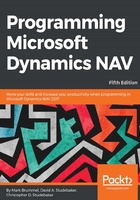
Multi-user Navigator
In 1987, PC & C released a new product, the multi-user Navigator, and a new corporate name, Navision. Navigator was quite a technological leap forward. It included the following:
- Client/Server technology
- Relational database
- Transaction-based processing
- Version management
- High-speed OLAP capabilities (SIFT technology)
- A screen painter tool
- A programmable report writer
In 1990, Navision was expanding its marketing and dealer recruitment efforts into Germany, Spain, and the United Kingdom. Also in 1990, V3 of Navigator was released. Navigator V3 was still a character-based system, albeit a very sophisticated one. If you had an opportunity to study Navigator V3.x, you would instantly recognize the roots of today's NAV product. By V3, the product included:
- A design based on object-oriented concepts
- Integrated 4GL Table, Form, and Report Design tools (the IDE)
- Structured exception handling
- Built-in resource management
- The original programming language that became C/AL
- Function libraries
- The concept of regional or country-based localization
When Navigator V3.5 was released, it also included support for multiple platforms and multiple databases. Navigator V3.5 would run on both Unix and Windows NT networks. It supported Oracle and Informix databases as well as the one developed in-house.
At about this time, several major strategic efforts were initiated. On the technical side, the decision was made to develop a GUI-based product. The first prototype of Navision Financials (for Windows) was shown in 1992. At about the same time, a relationship was established that would take Navision into distribution in the United States. The initial release in the US in 1995 was V3.5 of the character-based product, rechristened Avista for US distribution.